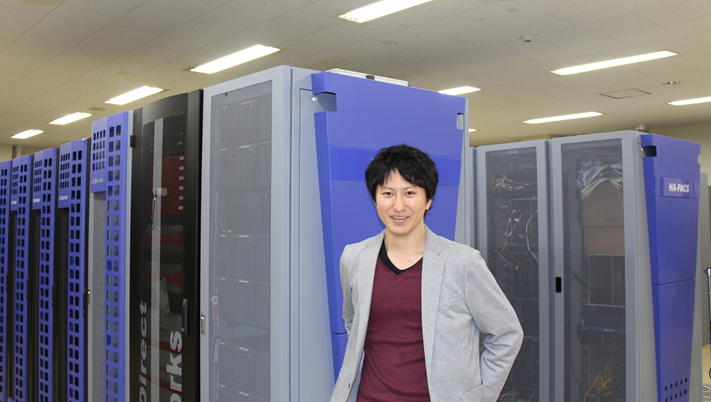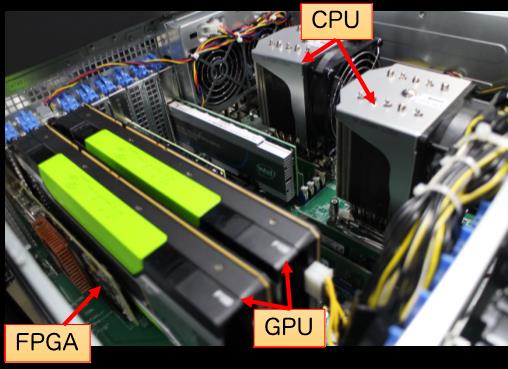TSUKUBA FUTURE
#091 Changing Calculations with Soft Hardware
Assistant Professor KOBAYASHI Ryohei, Center for Computational Sciences

Supercomputers are now a fundamental element to advancing computational science. There is currently active research and development into methods to further advance computing and energy-saving performance throughout the world. There are various approaches to improving these capabilities, however, and the types of computation at which these different schemes excel are themselves different. One approach receiving much attention of late is known as "soft hardware." Using this approach, new computer systems are being developed that can efficiently perform a variety of scientific applications.
Among the most famous supercomputers is the K computer, which in 2011 became the world's fastest. In 2016, the Oakforest-PACS supercomputer that is being run by the University of Tsukuba in conjunction with the University of Tokyo achieved a performance level exceeding the K supercomputer. However, this was measured by its ability to find solutions for simultaneous linear equations utilizing a program called the LINPACK, and although it excelled in those specific calculations, it does not necessarily mean that the computer will perform well in other scientific applications. The speed at which massively parallel supercomputers compute depends on the scientific applications that need to be performed, and their structure--that is, the structure of the hardware that controls computation and the mechanisms for data communication. Therefore, it is not uncommon for programs to be slower on Oakforest-PACS than on the K computer. Normally, once a supercomputer is developed, especially the processing configuration--the hardware that controls computation--cannot be modified. This means that due to their structure, processors remain inept at certain calculations, and even when configurations are optimized, the benefits are only to an extent. Drawing particular attention now is the Field Programmable Gate Array (FPGA), a "soft" hardware which allows the digital circuitry pattern to be programmed. It is an approach that improves energy-saving and computation performance of supercomputers as a whole by programming functions that enable rapid computation of previously problematic calculations. Prof. Kobayashi believes that this soft hardware may be the key to changing the world of high-performance computation.
The CPUs (Central Processing Units) that are the brains of computers have seen amazing growth in performance, but a limit has begun to appear where faster processing speeds are concerned. In response to this limit, devices called GPUs (Graphics Processing Units) came to be used. Originally developed for image processing, they are suited to simultaneous parallel processing of numerous calculations, and so efforts are being made to apply them to scientific applications as well. In the world of supercomputers, there have been many research and development cases where GPUs have been utilized. However, GPUs should not be regarded as all-powerful, as, among others, they consume large amounts of power, and they do not readily handle complex processing in which calculations are branched according to conditions. As mentioned above, once the core of CPUs and GPUs have been created, they cannot be modified; hence the name hardware.
Enter the aforementioned FPGA; programmable semiconductor devices, or "soft" hardware in which the internal digital circuitry can be rewritten. They have themselves been around since the 1980s, but their performance was deemed inferior, and they were not used much. Several years ago, however, there was a major shift triggered by research results announced by Microsoft to increase search speeds using FPGAs. Put simply, the research showed that when CPUs and FPGAs are used in tandem, FPGAs enable computation speeds about twice that of when CPU software is used alone. Thus, when using FPGAs, only half the resources are necessary to achieve the same performance; an aspect also advantageous with respect to power efficiency. However, in digital circuit programming, it is necessary to specify in detail just what kind of calculation is to be performed, in what way, and with what timing, and so mastering the use of FPGAs is very difficult. One of Prof. Kobayashi's research topics is how to simplify this to some extent.
What Prof. Kobayashi aims for is the construction of a completely new calculation system in which CPUs, GPUs, and FPGAs are combined skillfully based on a thorough understanding of their respective characteristics, with mutual support of weak areas and efficient data exchange in order to rapidly derive calculation results, with low power consumption. What must be done in order to achieve this are a truly diverse range of processes that include understanding what is to be calculated, and the data to be input; constructing a method for efficient processing; and estimating the theoretical performance of the computer from the devices used. The interior of a supercomputer is akin to a collaboration of a variety of devices, and in order to efficiently compute the targeted calculations, these devices must be managed as one, and a framework needs to be built that allows each to carry out mutually coordinated operations.
Prof. Kobayashi maintains that the real joy in computing comes from performing the programming that makes devices run so as to rapidly produce correct results. No matter what the performance of a supercomputer, its value is first realized when it is given a problem to be solved. On the other hand, there has been a steady increase in calculations that would not be possible without supercomputers that can handle enormous quantities of data--from explorations of the origin of the universe to climate simulations, molecular designs in the development of new drugs, and AI machine learning, among other areas. The awesome power of supercomputers is exhibited only when there is cooperation between persons who are thoroughly versed in programming of and the performance of the supercomputer, and persons with a research theme requiring calculations. Soft hardware will open up applications for high-performance computers and bring more abundance into our lives.

In addition to the Oakforest-PACS system in the Kashiwanoha Campus of the University of Tokyo, the COMA supercomputer is in operation at the University of Tsukuba. The HA-PACS/TCA shown in the photo ceased operation in March.

The inside of a computation node of the Pre-PACS-X (PPX) cluster system currently in operation at the Center for Computational Sciences. It consists of two CPUs, two GPUs, and one FPGA.
Article by Science Communicator at the Office of Public Relations


